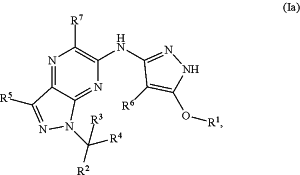| CPC C07D 487/04 (2013.01) [C07D 519/00 (2013.01); C07B 2200/05 (2013.01)] | 18 Claims |
|
1. A compound of Formula (Ia),
 or a pharmaceutically acceptable salt thereof, wherein
R1 is C1-C4alkyl optionally substituted with 1 to 4 groups each independently selected from halo and D;
R2 is C1-C4 alkyl or Ring A, wherein the C1-C4alkyl is optionally substituted with 1 to 4 groups each independently selected from halo, D, CN, and OH and/or 1 group of 5 to 6 membered heteroaryl having 1 to 3 ring heteroatoms each independently selected from the group consisting of O, S, N, and NRd; and
R3 is selected from the group consisting of H, D, C1-C4 alkyl, C3-C10cycloalkyl, and 4 to 12-membered heterocyclyl, wherein the C1-C4alkyl and C3-C10cycloalkyl are each optionally substituted with 1 to 4 Rc, wherein the 4 to 12-membered heterocyclyl has 1 to 4 ring heteroatoms each independently selected from the group consisting of O, S, N, and NRd and then is optionally substituted on a ring carbon with 1 to 4 Rc; or
R2 and R3 are taken together with the carbon atom to which they are attached to form Ring B, wherein Ring B is C3-C10cycloalkyl or 4 to 12-membered heterocyclyl, wherein the C3-C10cycloalkyl is optionally substituted with 1 to 4 Rb, wherein the 4 to 12-membered heterocyclyl has 1 to 4 ring heteroatoms each independently selected from the group consisting of NRd, N, O, and S and then is optionally substituted on a ring carbon by 1 to 4 Rb;
Ring A is selected from the group consisting of C3-C10cycloalkyl, phenyl, naphthyl, 4 to 12-membered heterocyclyl, and 4 to 12-membered heteroaryl, wherein the C3-C10cycloalkyl, phenyl, and naphthyl are each optionally substituted with 1 to 4 Ra, wherein the 4 to 12-membered heterocyclyl and 4 to 12-membered heteroaryl have 1 to 4 ring heteroatoms each independently selected from the group consisting of O, S, N, and NRd and then are optionally substituted on a ring carbon with 1 to 4 Ra;
Each Ra is independently selected from the group consisting of D, halo, OH, CN, C1-C4alkyl, and C1-C4alkoxy, or two Ra, attached to the same atom, form a ═O, wherein the C1-C4alkyl and C1-C4alkoxy are each optionally substituted with 1 to 4 groups each independently selected from the group consisting of halo, OH and CN;
Each Rb is independently selected from the group consisting of D, halo, OH, CN, C1-C4alkyl, and C1-C4alkoxy, or two Rb, attached to the same atom, form a ═O, wherein the C1-C4 alkyl and C1-C4 alkoxy are each optionally substituted with 1 to 4 groups each independently selected from the group consisting of halo, OH and CN;
Each Rc is independently selected from the group consisting of D, halo, OH, CN, C1-C4alkyl, and C1-C4alkoxy, or two Rc, attached to the same atom, form a ═O, wherein the C1-C4alkyl and C1-C4alkoxy are each optionally substituted with 1 to 4 groups each independently selected from the group consisting of halo, OH, and CN; or
Each Rd is independently selected from the group consisting of H, D, and C1-C6alkyl;
R4 is selected from the group consisting of H, D, and C1-C4alkyl optionally substituted with 1 to 4 groups each independently selected from halo, D and OH;
R5 is selected from the group consisting of H, D, halo, CN, and C1-C4alkyl, wherein the C1-C4alkyl is optionally substituted with 1 to 4 groups each independently selected from halo and OH;
R6 is H or D; and
R7 is H or D.
|